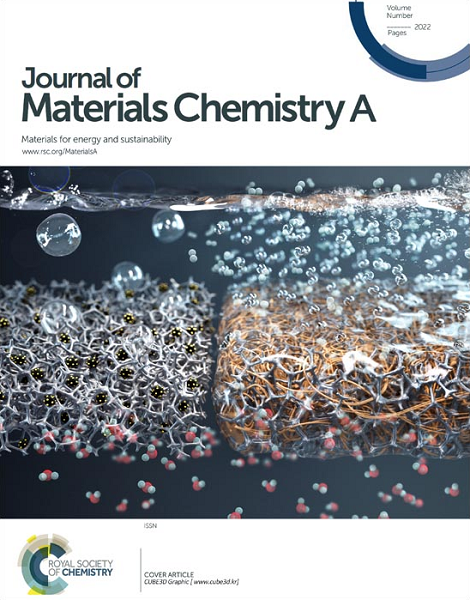微相分离诱导的聚齐瓦离子凝胶具有坚韧、高导电性、自愈合和形状记忆特性,适用于可穿戴电气设备
IF 10.7
2区 材料科学
Q1 CHEMISTRY, PHYSICAL
引用次数: 0
摘要
离子凝胶因其在构建可穿戴设备方面的独特优势而备受关注。然而,要将强韧性、高离子传导性、自愈合和形状记忆等特性整合到一种离子凝胶中仍然具有挑战性。在此,我们通过在 1-乙基-3-甲基咪唑鎓硫酸乙酯(EMIES)离子液体(IL)中共聚齐聚物[2-(甲基丙烯酰氧基)乙基]二甲基-(3-磺丙基)(SBMA)和丙烯酰胺(AAm),开发出了一种多齐聚物离子凝胶。聚丙烯酰胺(PAM)片段易于形成氢键,因此很容易在 EMIES 中聚集,从而形成富含聚合物的畴。与此相反,聚[2-(甲基丙烯酰氧基)乙基]二甲基-(3-磺丙基)(PSBMA)段与 EMIES 结合后会形成富溶剂相,因为它们具有良好的相容性。因此,在聚合过程中会产生互穿相分离结构。富聚合物相可以消散能量并提供高强度,而富溶剂相则使离子凝胶具有较大的拉伸性。此外,PSBMA 上的齐聚物基团可提供独立且连续的离子导电通道,促进离子传输。由于相分离和齐聚物特征的协同作用,所制得的离子凝胶具有均衡的机械和电气性能,韧性高达 2.7 MJ/m3,离子电导率为 1.3 mS/cm,并具有理想的自愈合能力。制备出的 PSBMA/PAAm 离子凝胶具有出色的温度和应变传感器性能。值得注意的是,该离子凝胶具有出色的形状记忆特性,能以非零高斯曲率固定在人体关节或物体上,并保持传感功能。因此,基于变形离子凝胶的传感器在检测具有复杂几何形状的物体的信号变化方面显示出巨大的通用性和潜力。本文章由计算机程序翻译,如有差异,请以英文原文为准。
Microphase separation induced polyzwitterionic ionogel with tough, highly conductive, self-healing and shape-memory properties for wearable electrical devices
Ionogels have aroused much attention due to their unique advantages for constructing wearable devices. However, integrating the properties of strong toughness, high ion conductivity, self-healing and shape-memory into one ionogel is still challenging. Herein, we develop a polyzwitterionic ionogel through the copolymerization of zwitterionic [2-(methacryloyloxy) ethyl] dimethyl-(3-sulfopropyl) (SBMA) and acrylamide (AAm) in ionic liquid (IL) of 1-ethyl-3-methylimidazolium ethyl sulfate (EMIES). The facile ability to engage in hydrogen bonds for poly acrylamide (PAM) segments makes them easily aggregated in EMIES, resulting in the formation of polymer-rich domains. In contrast, poly[2-(methacryloyloxy) ethyl] dimethyl-(3-sulfopropyl) (PSBMA) segments combined with EMIES form solvent-rich phase due to their good compatibility. Therefore, interpenetrating phase-separated structure is produced during the polymerization. The polymer-rich phase can dissipate energy and provide high strength, while the solvent-rich phase enables the ionogel with large stretchability. Besides, the zwitterionic groups on PSBMA can provide separate and continuous ion conductive pathways, facilitating the ion transport. Attributing to the synergy of phase separation and zwitterionic feature, the resulting ionogel presents balanced mechanical and electrical properties with high toughness of 2.7 MJ/m3 and ion conductivity of 1.3 mS/cm, as well as desirable self-healing ability. The resulting PSBMA/PAAm ionogel demonstrated excellent performance as a temperature and strain sensor. Remarkably, the ionogel possessed outstanding shape-memory property, making the ionogel can fix on the human joint or object with nonzero Gaussian curvature and maintains the sensing functions. Therefore, the morphing ionogel based sensor displays huge versatilities and potentials on detecting the signals variations for the objects with sophisticated geometries.
求助全文
通过发布文献求助,成功后即可免费获取论文全文。
去求助
来源期刊

Journal of Materials Chemistry A
CHEMISTRY, PHYSICAL-ENERGY & FUELS
CiteScore
19.50
自引率
5.00%
发文量
1892
审稿时长
1.5 months
期刊介绍:
The Journal of Materials Chemistry A, B & C covers a wide range of high-quality studies in the field of materials chemistry, with each section focusing on specific applications of the materials studied. Journal of Materials Chemistry A emphasizes applications in energy and sustainability, including topics such as artificial photosynthesis, batteries, and fuel cells. Journal of Materials Chemistry B focuses on applications in biology and medicine, while Journal of Materials Chemistry C covers applications in optical, magnetic, and electronic devices. Example topic areas within the scope of Journal of Materials Chemistry A include catalysis, green/sustainable materials, sensors, and water treatment, among others.
 求助内容:
求助内容: 应助结果提醒方式:
应助结果提醒方式:


